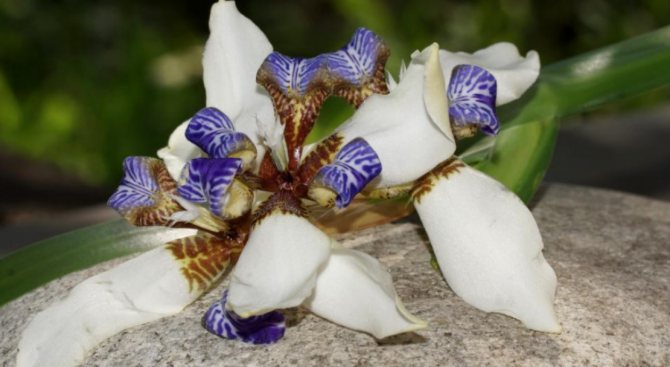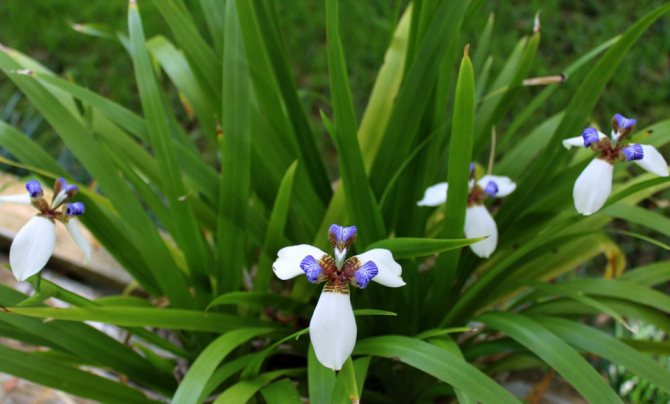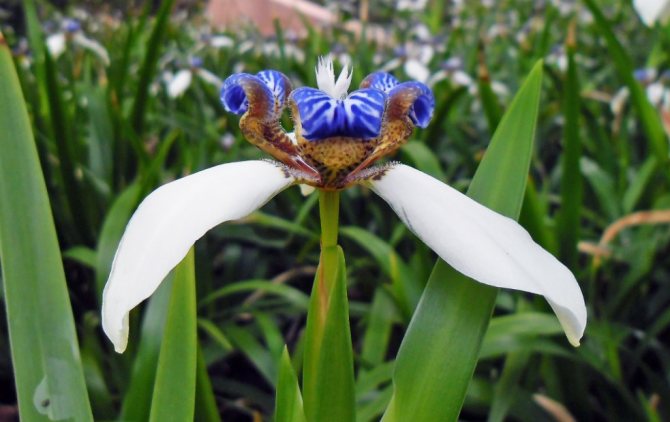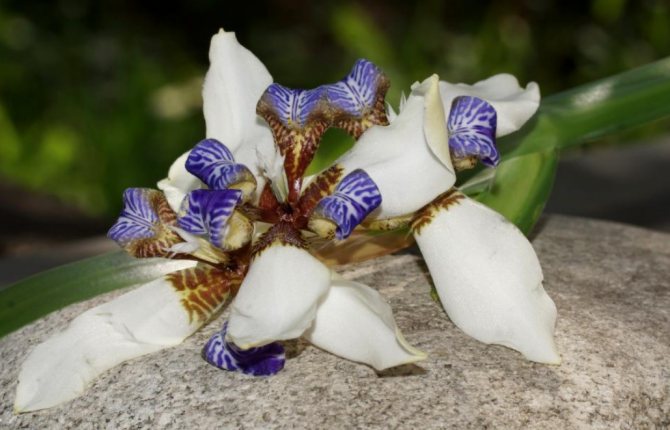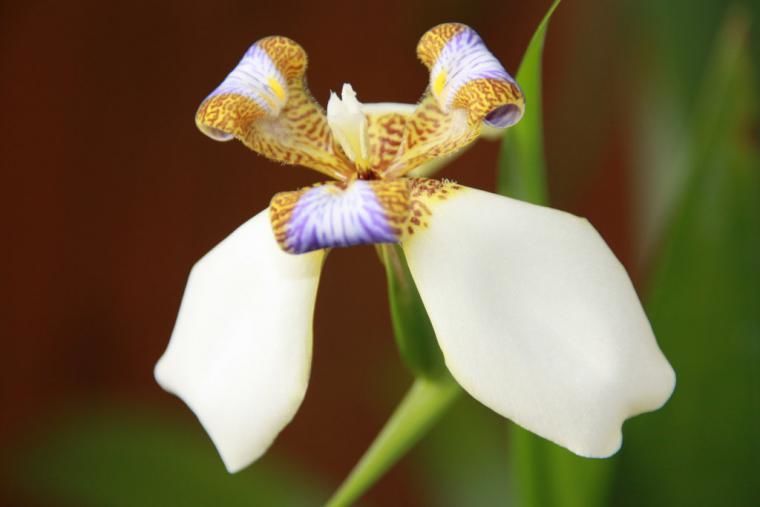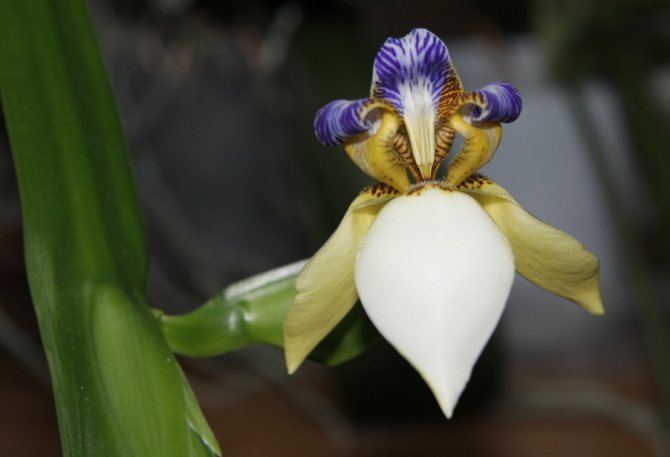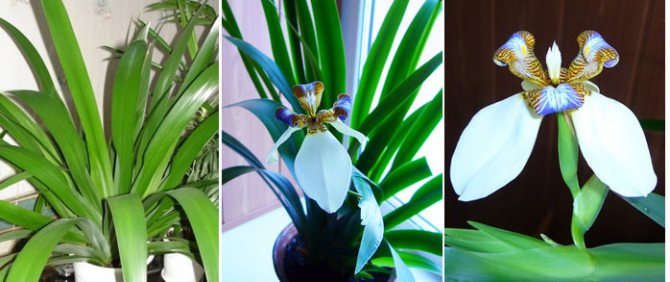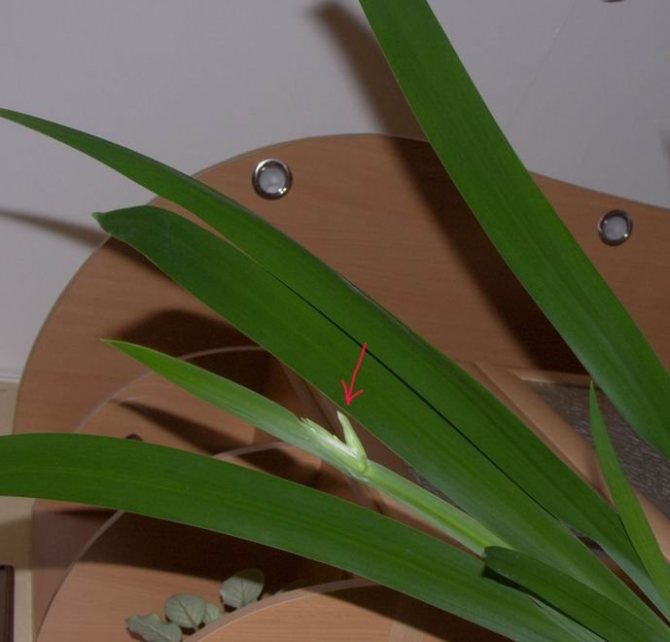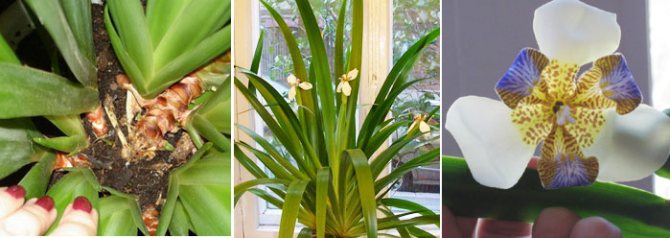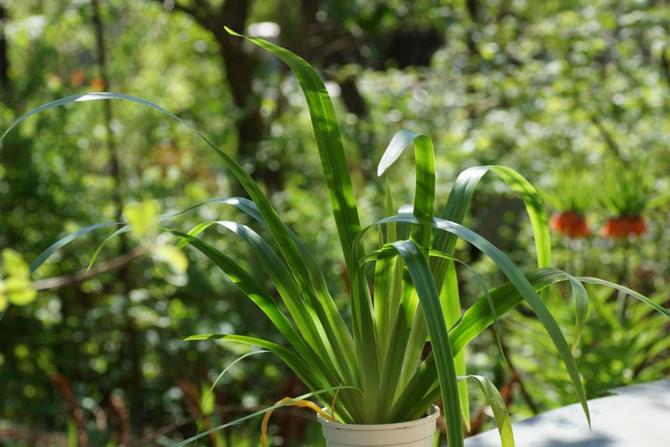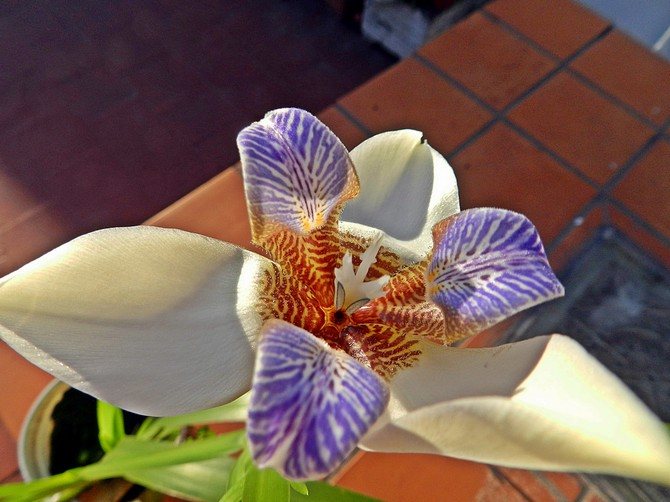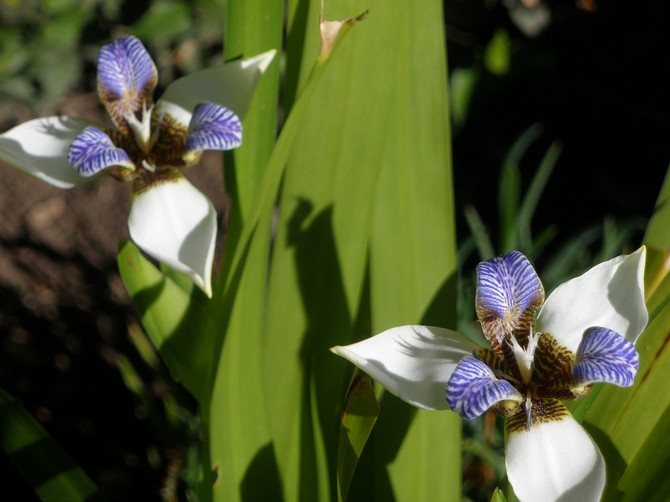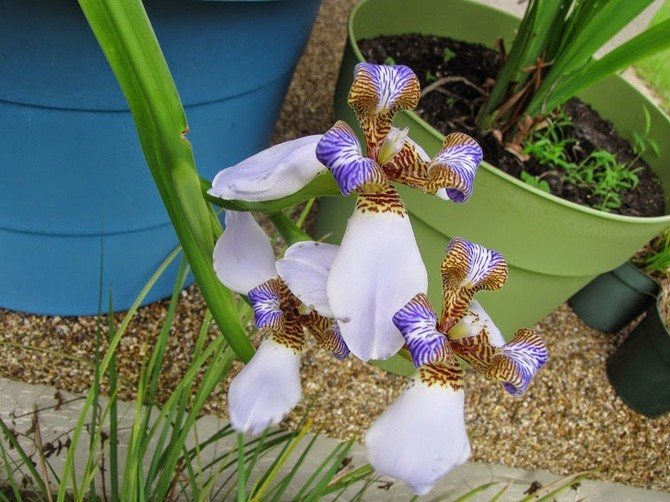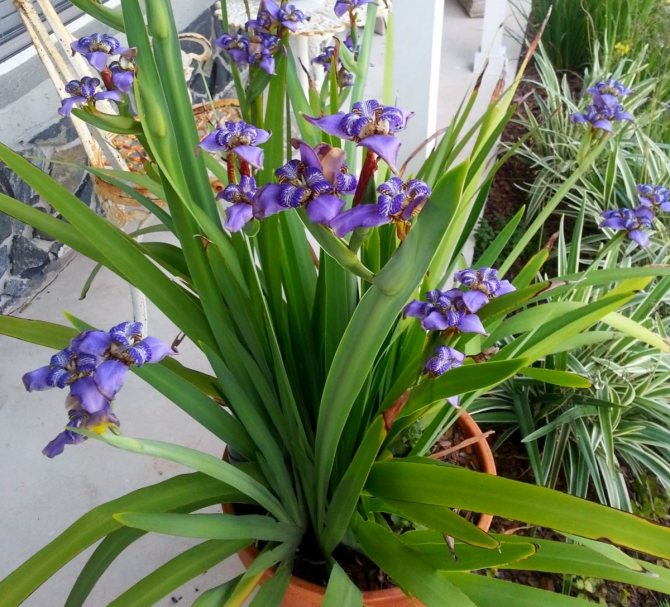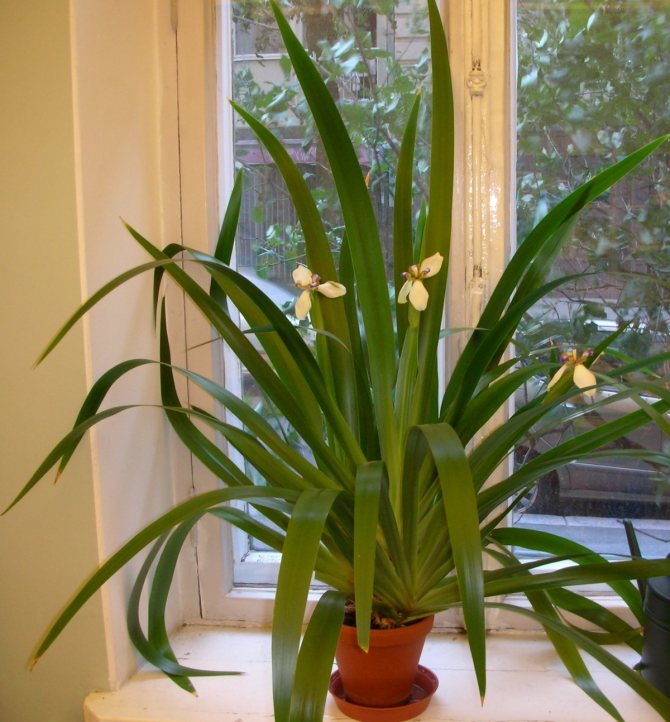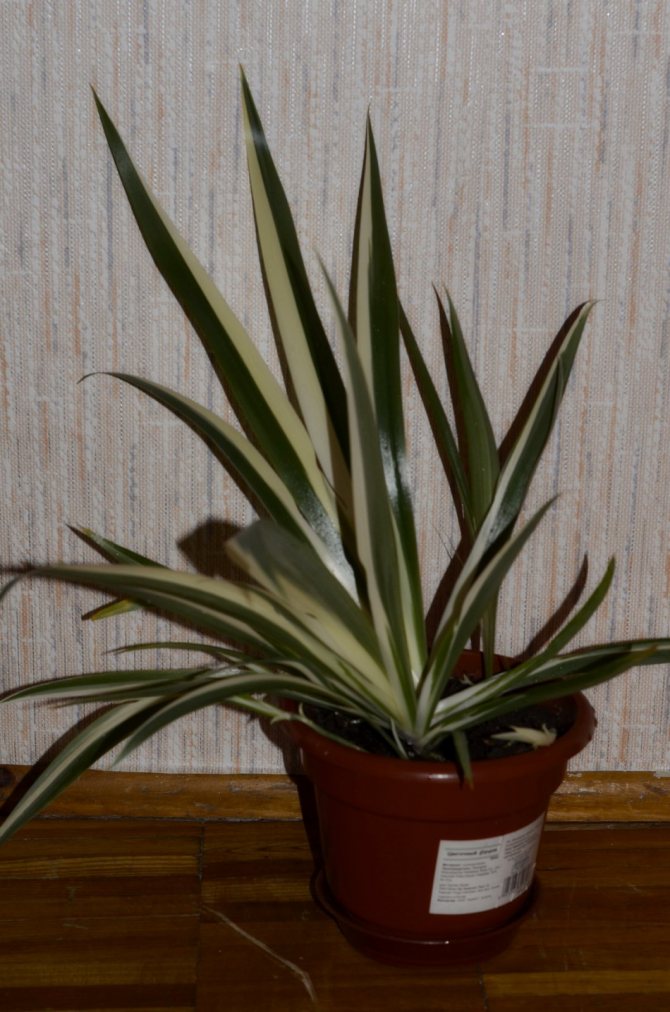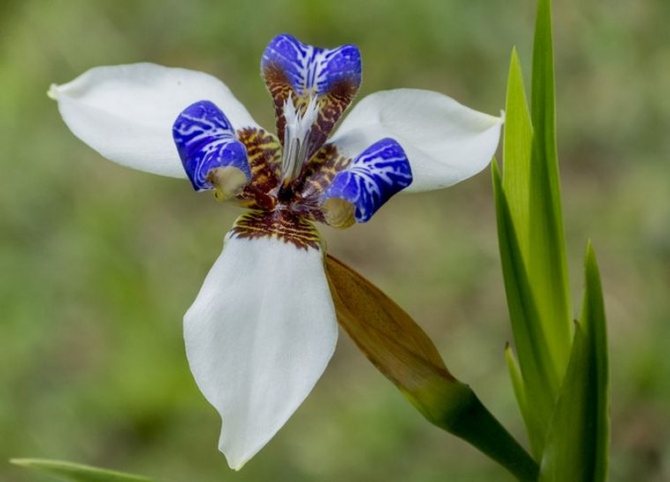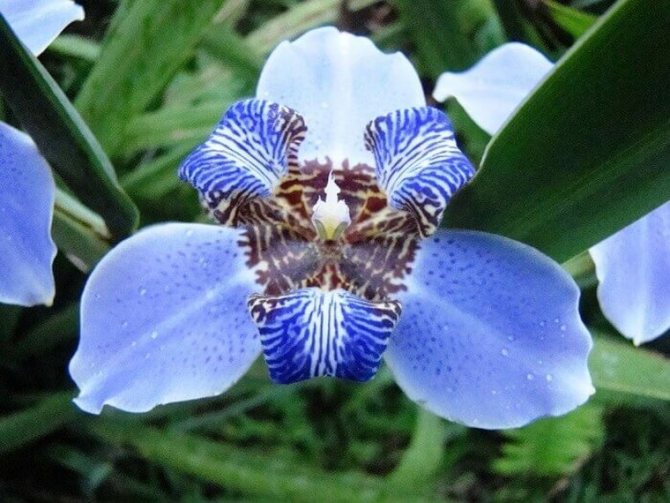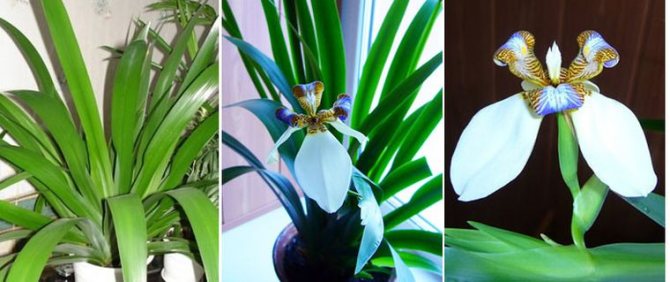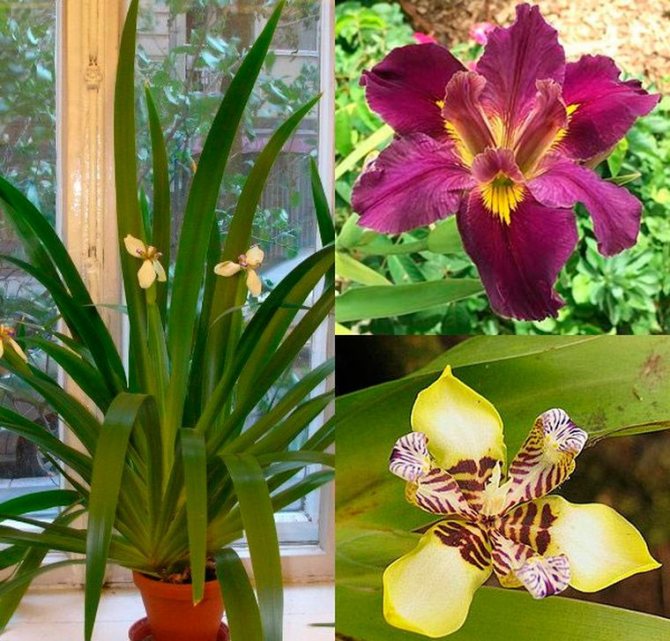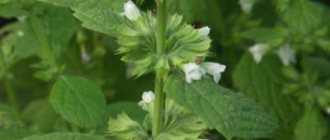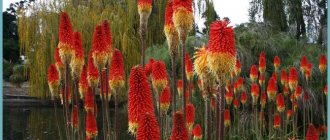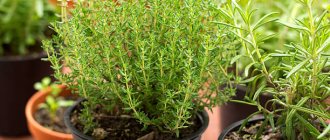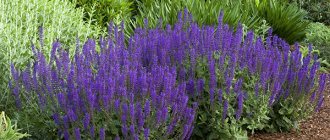Among the plants that came to us from the Latin American rain forests, the magnificent walking iris is far from the most modest representative of them. Due to its thermophilicity and capriciousness, it remains an indoor culture for countries with severe winters. Without losing at all its rather large size, the indoor neomarika looks elegant, graceful and very exotic. Flowers that can compete with orchids are a worthy reward for the special conditions that will have to be created for this plant.
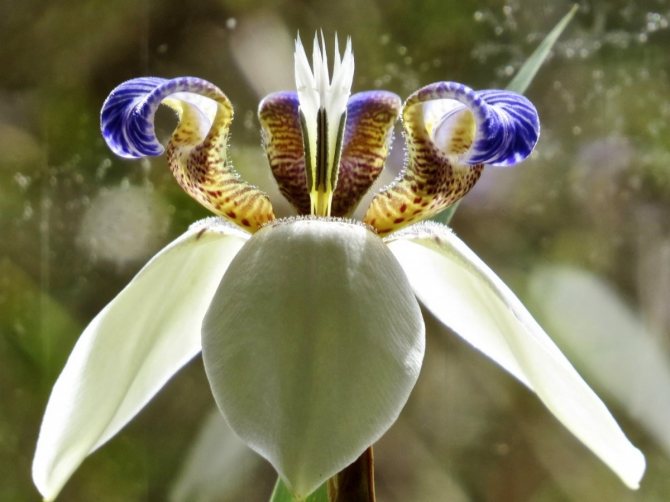
The walking iris, or Neomarika, is a magnificent exotic on the windowsill.
Botanical description
The neomarik flower is a herbaceous plant of the Iris family. The homeland of Neomarica is the wild forests of Colombia, Costa Rica, Central and South America. In another way, the plant is called “walking iris” because the peduncle, at the end of flowering, bends to the ground under its own weight, forming children that root themselves and the “twelve apostles” - because until the flower releases 12 leaf blades, it does not will open the buds. It is believed that the plant is named after the river nymph Marika, because neomarika likes to drink plentifully. The flower looks like a garden iris, being its closest relative.
The length of neomariki leaves ranges from 50 cm to 1.2 m, it depends on the species, of which there are about 20 in nature. It has xiphoid leathery leaf plates about 5-6 cm wide with embossed spectacular veins. Directly on the leaf from the thickness of the leaf plate, a flat peduncle develops, which has 3-5 buds. Flowers with an excellent aroma, up to 5 cm in diameter, are short-lived, stay on the peduncle for no more than a day, and in their place, offshoots appear later. The root system is superficial and branched. For decorative purposes, 2 types are used.
Amazing unpretentiousness, beautiful appearance, bright flowering of amazing neomariki attract more and more amateur flower growers.
Neomarika, or Walking iris - description of the plant
The elusive flowering, typical iris foliage, the status of a rare and almost exclusively valuable plant - everything in neomariki is attractive. These are some of those exotics that do not lose their unbridled character even when they are moved to a potted form.
In nature, neomariki are plants typical of the Brazilian flora. Their unique beauty is associated with the Amazonian jungle, although they are found in other Latin American countries and on other continents.
Neomarika is better known by her nickname "walking iris", although many growers call her "walking iris". The beginning of this nickname gave rise to the "behavior" of the plant. Neomariki boast very unusual natural reproduction.
When grown in soil, after flowering, shoots gradually develop in place of flowers, and the heavier they become, the more the peduncle tilts. After contact with the soil, the new plant takes root - one step away from the mother bush.
That is why this amazing type of irises is called walking. Another beautiful nickname for the plant is the apostolic iris. According to legend, 12 leaves must be released to release flower stalks, and many see this as a small miracle.
Walking iris, or Neomarika Is an evergreen, herbaceous perennial. A shallow, vigorous root system with thickened creeping roots and rosette basal leaves are typical of this family.
Even in room form, walking iris can produce leaves up to 60 cm in length. Dense sods look elegant and luxuriant, and the ideal belt-like-xiphoid shape of the leaves is rarely spoiled by bends or slopes.
Leathery, rather tough, with a slightly pronounced gloss, neomariki leaves are limited in width to a maximum of 3–4 cm with a length of 50 cm and more. Their color is muted-medium, the surface is semi-gloss.
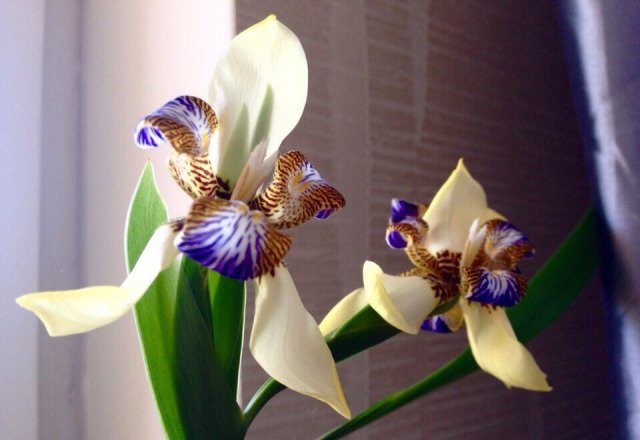

Most indoor neomarik blooms only at a respectable age. <>
Blooming neomariki
Traditionally, neomarica blooms in early summer; with sufficient lighting in regions with severe winters, it can bloom in May. The natural cycle of neomariki involves flowering in early spring, but indoor plants change their character, adapting to the capabilities of the owners.
Most neomarik flowers only at a respectable age. Full flowering is observed if about 10-12 leaves grow in the outlet. But sometimes walking irises bloom much earlier.
Watching the neomariki bloom is a great success. And the point is not at all that it blooms poorly in room culture. It's just that the whole process is happening so quickly that you can only catch a flower at the peak of decorativeness by dedicating a day to it in anticipation of a miracle.
Graceful, with beautiful lines and details, unique patterns, the bloom of neomariki is mesmerizing. The development of carnal peduncles with almost flattened buds can be skipped, because the peduncles literally merge with the leaves, only a bright yellow color and motley ripples of patterns on the buds are visible near.
The height of the peduncles, even in pots, may not be limited to values of 80-100 cm. The buds are transformed before our eyes, developing from flat to spherical, turning pale in one day. As the sun rises, the flowers gently and slowly open their petals, allowing you to admire their beauty for several hours at the peak of the day, so that at dusk there will be no trace of it.
But on the same peduncle, the next flower opens the next day. In general, flowers on this unique plant last no more than 15 hours, most often they wither within one day. Each peduncle blooms from 3 to 15 buds. In the indoor format, the number of flowers is most often limited to 4–5.
Neomariki flowers are very similar in shape to iris flowers. The three outer and three inner perianth lobes differ in size and shape. Large, oval, with a slightly wavy edge and a variegated throat, the lower petals in the “triangle” emphasize the grace of 2 or 3 smaller ones, with a thin “stem” and heart-shaped, variegated over the entire surface of the upper ones. Classic, overlapping triangles create a strict elegance.
The color scheme of walking irises is very effective. It includes only two color variations for the three lower "petals" - creamy white and light blue, but for the "crown" it is much more varied. Spots, specks, strokes and patterns on a bright blue-purple background, as if flowing into the throat of a flower, can be white, blue, dark purple, brown, yellow. They mix in almost "animal" color options and offer a varied luxury to admire.
All neomariki pleasantly surprise with a light but delicate aroma. In neomariks with brighter colors, it is, as a rule, more pronounced than in plants with creamy petals.
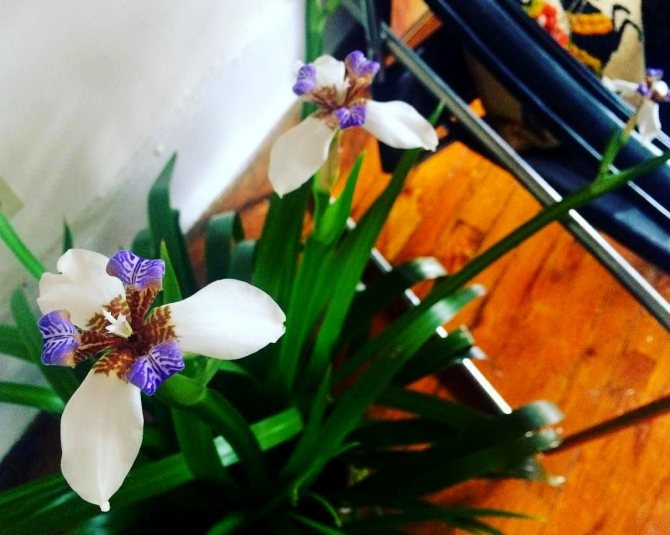

Neomarica graceful, or slender (Neomarica gracilis). <>
Growing and caring for a neomarik flower at home
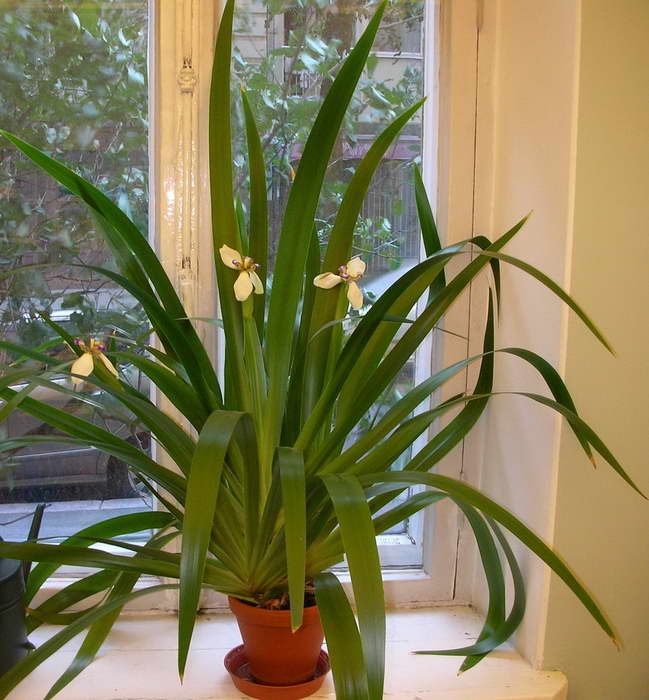

Neomarik flower photo at home
Location selection and lighting
Neomarica is placed on windows of east, west or north orientation.The sun's rays leave burns on the leaves, which negatively affects the appearance - the plant is shaded from the midday bright rays.
Air temperature
Neomarica develops well at normal room temperature, and its natural decrease in winter is beneficial to the flower, it serves as a guarantee of bright flowering.
Watering and spraying
Spraying, especially at high indoor temperatures, has a positive effect on the condition of the flower. He also benefits from a warm shower at any time of the year.
Water for irrigation is used soft - thawed, boiled. Watering depends on the time of year: in summer it is more abundant and frequent, in autumn it is reduced, and in winter it is minimized, arranging a rest period for the neomarika, at least 2 weeks. Cool wintering is a guarantee of lush and abundant flowering. The constant high temperature of the content leads to the fact that the neomarica refuses to bloom. Move it as close to the glass as possible - this will be enough to admire the flowering.
Priming
The composition of the potting mix does not really matter - any universal soil from the store will do it. She does not like oily soils, because grows in nature on a poor substrate. In the form of mulch, you can add a small amount of coniferous soil. It is better to choose a ceramic pot - it is heavier, this will prevent the flower from falling on its side.
Top dressing
For this reason, feeding is almost not required for it, only at the beginning of active growth it is recommended to feed it with liquid complex fertilizer. Overfed neomarika blooms reluctantly or does not release a peduncle at all.
How to care for a neomarika
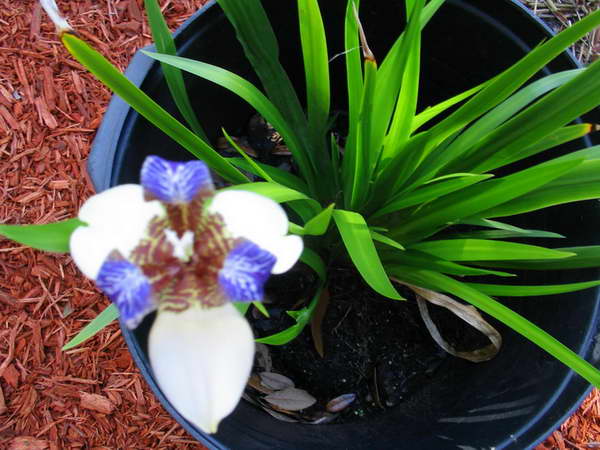

Neomarik flower how to care at home
For the summer period, it is preferable to take a pot with neomarika to the garden or to the balcony, preventing the soil from drying out, protecting it from the scorching sun and cold wind.
If necessary, cut off dried leaves. If you do not want to propagate the plant, the faded peduncles are cut off, not allowing the shoots to form, because this significantly weakens the mother bush.
If the neomarika doesn't like something during budding, she may not open the flowers - they will immediately turn into children.
Transfer
Young plants are transplanted every year, using the transshipment method - without disturbing the earthen coma, slightly increasing the pot and adding a small amount of fresh soil. Older plants are transplanted less frequently. If you use too large a container when transplanting, the plant may not bloom until its roots fill the volume provided to it. The planting pot is chosen wider than its height. Drainage at the bottom of the flowerpot is necessary for the timely outflow of excess fluid.
Recommendations for indoor growing neomariki
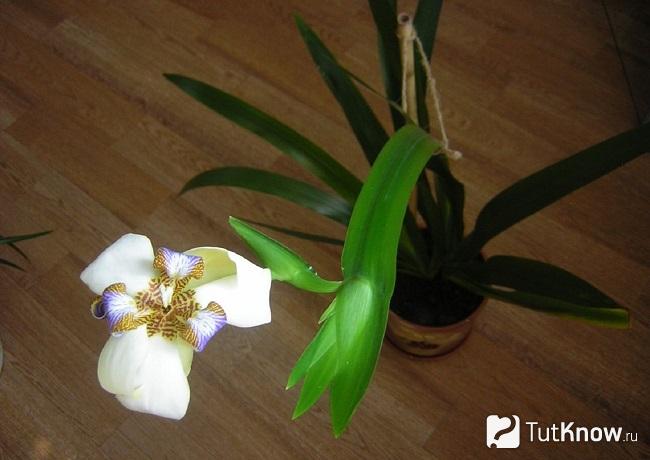

- Lighting and location selection.
"Walking iris" should be kept in bright, but diffused lighting, which can be provided on the windowsills of windows with an east or west orientation. In winter, backlighting should be carried out using phytolamps, especially if the heat indicators are reduced. On the southern window, the plant may develop leaf burns from direct sunlight. - Content temperature.
For "walking iris" maintain room heat indicators when the temperature fluctuates between 20-25 degrees. But if autumn comes, then it is recommended to smoothly lower these values to 5-10 units. If this is not done, then there will be no flowering in the summer. - Air humidity
when growing neomariki should be medium - 50-60%. This will be the key to normal development and subsequent flowering. In the summer, you can spray the leaf plates with soft and warm water, trying to prevent moisture drops from falling on the flower petals. In winter, if the "walking iris" is kept at elevated heat values, it is also recommended to irrigate the leaves from a spray bottle, especially if heating devices are working.You can periodically arrange "showers" to wash the dust off the leaves. However, according to experienced flower growers, the plant is not demanding in terms of humidity and can adapt to the dry air of residential premises. But if you carry out regular spraying, then "walking iris" will respond with lush leaves of saturated color. - Watering.
When the time of spring-summer comes and the temperature increases, the neomarica is watered abundantly, especially when flowers appear (approximately every 2-3 days). When mid-autumn comes and the plant goes into dormancy, the moisture is reduced to 1 time for 7 days, and even less often in winter, but it is not brought to complete drying. Only soft and warm water is used. - Fertilizers for neomariki
are introduced during the period of increased growth (from April to October) only once or twice a month, since in nature the plant grows on poor substrates. Orchid feed is used, preferably in liquid form. - Transplantation and selection of a substrate.
Neomarika will require a transplant every 2-3 years in the spring, when she is an adult, but the "young" are changed the pot and the soil in it every year. At the same time, in a new pot, not only the root system and up to 5 cm of the stem are buried in the soil. But more immersion in the ground is undesirable. A new container for transplanting is selected not too deep, since the root system does not differ in power, but is located superficially. Better to use pots made from clay. When transplanting, there is no need to divide the specimen if it has not grown too much. It is beautiful when there are several plants in one container. At the bottom, there should be a layer of drainage material - medium-sized expanded clay or pebbles. When replanting, it is recommended to use light soil with good air permeability and drainage, the acidity values of which are in the pH range 6–7. If the soil is prepared independently, then garden soil, coarse sand (perlite), peat are combined for it in a ratio of 3: 1: 1. - Dormant period
in neomariki, it begins in mid-autumn and lasts until the end of February. At the same time, it is recommended to reduce the heat indicators to 5-10 degrees, but at the same time to increase the lighting level. - General care.
Since the leaves of the "walking iris" are quite long and sometimes their tops are bent down, the plant can be grown as an ampelous crop in hanging pots. But since “babies” are formed on the peduncles after flowering and the stem bends under their weight, such daughter formations, touching the soil in neighboring pots, begin to actively root there. Therefore, it is not recommended to put pots next to other representatives of the flora, maintaining a distance of up to half a meter.
Reproduction of neomariki
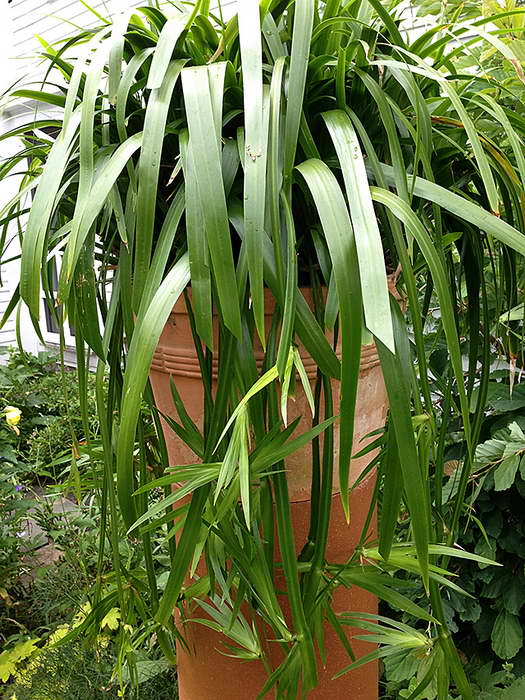

How to propagate neomarika walking iris photo of children
Neomarica is propagated by dividing the bush and rooting children. Usually the rhizome is divided when transplanting an adult flower. The curtain is carefully divided into several parts so that each has at least 3 growth points, placing them in separate pots.
The offshoots that form on the peduncle are an excellent material for obtaining new plants. You can just put a pot of earth next to the flowering specimen, and force the peduncle with the children to bend down to this flowerpot and fix its end in the substrate with a V-shaped wire.
Curious facts about neomarik
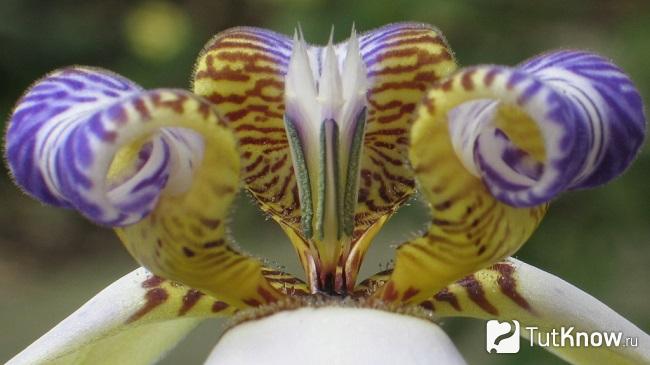

You can hear how among flower growers neomarica is called not only a walking or walking iris, but also an "apostle plant", since there is a belief that this plant will not bloom until it acquires, at least at least twelve leaves (12 is the number of Jesus' disciples-apostles). But there is a more unflattering name for it "devil's paw", apparently - this is due to the shape of the flower.
Important to remember! All parts of neomariki are very poisonous, therefore, after working with it, you must thoroughly wash your hands and do not install the pot with "walking iris" in children's rooms and in the accessibility of pets.
Pests and diseases
This plant practically does not get sick, it is rarely affected by insects. With increased dryness of the surrounding atmosphere, the appearance of a spider mite is likely. If there is a thin web between the leaves, treat the flower with an appropriate insecticide.
If you do not want to use chemistry, a positive effect can be achieved if you do a warm shower every day, thoroughly washing off all the leaves. Adding a small amount of laundry or tar soap to the water for washing the leaves will greatly enhance the effect of these procedures.
Neomariki leaves turn yellow
When the soil is waterlogged during wintering, root rot may appear, and the leaves of the neomariki turn yellow.
- It is recommended to remove the neomarica from the pot, remove the affected areas of the roots, and sprinkle the rest with charcoal or activated charcoal.
- The plant is planted in a new pot with a fresh disinfected substrate (you can pour it with a phytosporin solution).
- Transplantation and root decay can be prevented by using sphagnum moss. Spread out in a thin layer on top of the potting mix, moss helps fight various misfortunes. It has high hygroscopicity and bactericidal properties, absorbs excess liquid, preventing the development of diseases. The moisture evaporating from the moss surface additionally humidifies the air near the flower.
Such a wonderful plant deserves more attention. Excellent bright malachite foliage purifies the atmosphere of any room, looks great, perfectly decorates the interior, and brings a lot of positive emotions to its owners.
August
In August, you can also transplant and divide irises. In bearded irises, break the rhizome with your hands, dry it in the sun or powder the divisions with crushed coal. Shorten the leaves to a length of about 15 cm, and the roots up to 10 cm. For 1-2 weeks, put the cuttings in a dry and ventilated room, wrapping the roots in a damp cloth. Then plant the plants 5-7 cm deep.
Do not dry bearded irises, do not shorten their roots and plant immediately without aging indoors, and not deeply, but at the level of the soil surface.
Types of neomariki with photos and names
Neomarica slim Neomarica gracilis
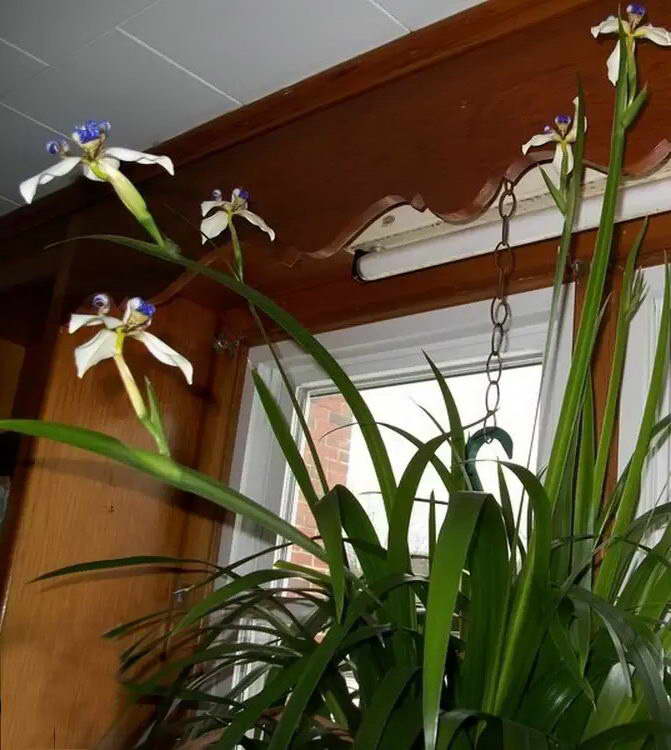

Neomarika slim photo at home
It has leaves arranged in a fan, and the peduncle carries up to 10 buds, which open gradually. One-day flowers are colored golden and milky. It is she who is grown in apartments and houses.
Neomarica northiana or walking iris Neomarica northiana
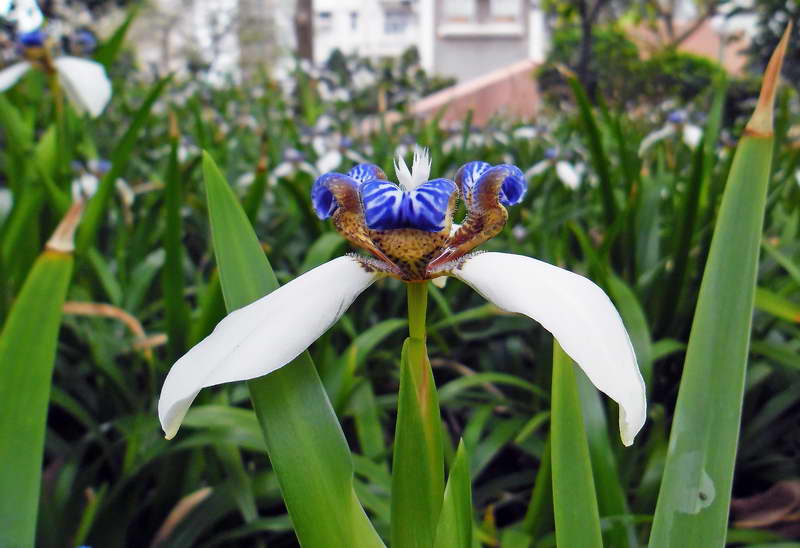

Neomarica northern or walking iris Neomarica northiana photo
Dissolves purple with blue tint fragrant flowers with golden stripes in the middle. It is more compact in comparison with the previous type.
Neomarica Karulea Neomarica Caerulea


Neomarica Neomarica Caerulea photo at home
A beautiful ampelous view with picturesquely hanging graceful leaves and long peduncles. It is not difficult to achieve flowering at home.
How to avoid mistakes when forcing irises
In the first years of research, we took planting plots from perennial highly overgrown bushes. They received flowering at home in winter, but they were unstable in different years and with a low percentage of flowering shoots. The explanation for this is that in a large bush, rhizomes are cramped and few leaves are formed, which means that flower buds are poorly laid. This prompted us to think about growing the planting material specifically for forcing. Three weeks after flowering, which falls on the end of June - beginning of July, we divided a perennial bush and planted one-year and two-year shoots of rhizomes on the ridges. In September, the plants from the ridges were planted in vessels (boxes can be used) and left dug on the ridges until frost.In early November, the irises were removed to the basement (+ 4 ° С). During storage, they made sure that the earth in the vessels did not dry out. They took it from the basement in the 3rd decade of January and put it into the light in the classroom.
Flowering began at the end of February. The grown one-year and two-year shoots bloomed profusely. Non-grown one-year-old shoots did not bloom at all, and two-year-old ones bloomed very weakly in comparison with grown ones. So, empirically, we have determined that it is better to grow the planting material for forcing.
1998-1999 staged another experiment to find out how the age of the germinated planting material affects the flowering of irises in forcing. Planted one-year, two-year and three-year shoots.
We call an annual shoot a juvenile (not yet flowering) shoot of an annual growth (one apical link of the rhizome with a fan of leaves). A two-year shoot is a juvenile shoot of a one-year growth with last year's growth (two links). Three-year-old - juvenile shoot of one-year increment with increments of two previous years (three links).
Before planting in forcing vessels, the number of leaves in the fans of each plant was counted. Annual shoots had from 3 to 7. Apparently, the conditions of the summer of 1998 (drought) did not favor the growth of leaves. Therefore, the flowering in winter was very weak.
Two-year-old shoots had leaves from 5 to 10. Irises from these shoots bloomed profusely - 80% of them gave flower stalks, most plants have 2 peduncles.
Three-year-old shoots bloomed well, but weaker than two-year-old ones - 70% gave peduncles and there were fewer peduncles.
Thus, it turns out that annual shoots, even sprouted ones, can not bloom well every year when forcing, while cultivation of two-year shoots provides abundant and stable flowering.
How to grow bearded irises on the balcony
Greetings, friends!
Irises have always attracted attention with their beauty and aroma. Bearded varieties brought from Germany look beautiful both in the garden and in a pot on the balcony. This unpretentious type of irises grows beautifully in any conditions. They can be planted both in spring and in summer, and even in autumn.
When grown by seed, the irises become smaller and less beautiful.
In order to conduct growing irises
at home
and on the balcony, it is best to purchase a ready-made plant with a developed root system, without damage. The bulb should have the beginnings of new roots. Her color should be uniform, without dark spots. The root part should be green, rich in color and have about 10 leaves.
When the plant is purchased, it needs to be dried a little so that the upper part of the root system is slightly weathered.
To plant irises on the balcony, you need to take a mixture of soil with peat and the addition of phosphorus nitrogen and potassium fertilizers, instead of potash fertilizers, you can take ash, at the rate of 30 grams per plant. The soil can be alkaline or slightly acidic, necessarily light and loose. It is not advisable to add organic fertilizers, otherwise the plant will become thickened and start to hurt.
At the bottom of the container, where the iris will grow, you can pour a layer of shells, pebbles or expanded clay. To prevent moisture stagnation, there must be holes in the container.
In a small hole, a root (bulb) is planted so that the above-root part remains practically free and is watered with settled water.
At first, seedlings can stand in a dark, cool place if flowering is expected in winter. Or it is exhibited right away on the balcony so that it blooms in early autumn.
Also, for better growth, the rhizome should be tilted slightly to the south so that the upper part of the iris goes north. This allows the plant to grow faster and not get sick.
At the beginning of winter, irises are exposed to the light so that they bloom by February.
When planting several plants at once, you need to purchase separate pots or a long container for them, which will allow you to plant them spaciously, since irises do not like crowding. The distance should be at least half a meter between them. Low-growing (dwarf) varieties can be planted at a distance of 25 centimeters.
Around the plant, you need to loosen the soil and eliminate weeds as they appear. It is impossible to water the soil too much, since all varieties of bearded irises do not like excess moisture.
Miniature dwarfs, these are early varieties of bearded irises, reaching a height of 20 centimeters and having large beautiful flowers.
The standard dwarf varieties, which grow up to 35 centimeters, bloom after the miniature species.
Medium varieties of bearded irises reach 70 centimeters.
Tall bearded irises are considered more popular.
For growing bearded irises on a glazed balcony in winter, Siberian iris, Aryl, Ideal, Appolo are suitable.
When the plant grows, after two years it can be divided and transplanted.
What is distillation?
There is general information about what distillation is that all novice growers need to know. Plants of the temperate zone are dormant in winter at low temperatures. But among them there are many who lay flower buds by winter and bloom in early spring. However, if you change the conditions and, first of all, increase the temperature and humidity, then the plants with flower buds will bloom in the winter in the house. To create such conditions, you can use basements, sheds, shelves of household refrigerators, that is, rooms with a low positive temperature. For forcing, we used low-growing purple irises that bloom in late May and early June (simultaneously with lilacs).
How to grow irises?
How to grow irises. Irises: home care. Irises: soil. Irises: transplant. Conditions for growing iris.
Iris reticulata
Most plants in the Iris family are too large to grow in pots, but there are a few dwarf irises that are great for home keeping. They all grow from rhizomes, which must be planted in early autumn so that the irises bloom in late winter or early spring.
Plant 6-8 rhizomes in a 12 cm pot or bowl, covering the rhizomes with soil.
Irises do not need to be kept in the dark after planting in pots - a cool, bright place, such as a shaded window sill, will do. When the plants are ready to bloom, transfer the pot to a well-lit area. Be careful not to overfeed dwarf irises, as this will result in many offspring but no flowers.
Varieties of iris: Iris reticulata. Iris danfordiae, Iris bakeriana and Iris histriodes.
Conditions for keeping irises
Illumination: Provide moderate light during growth and full light during flowering. When the plant is blooming, shade it from direct sunlight.
Temperature: during the growth period, keep the planting at a temperature of 4-7 degrees, during flowering, make sure that the temperature does not exceed 13-16 ° C.
Irises watering: After planting the rhizomes, saturate the potting mix with water, then water the plant once a week to keep the soil moist. Water 2-3 times a week during flowering.
Air humidity: keep the plant cool and dry. Do not spray it.
Irises top dressing: if you plant a rhizome to grow it for subsequent plantings, then every 10 days apply liquid fertilizer for indoor plants, diluted to the manufacturer's recommended concentration. Start feeding when the flower buds form and stop when the leaves are dead.
Soil for irises: clay soil mixture for indoor plants or a special fibrous substrate for bulbous.
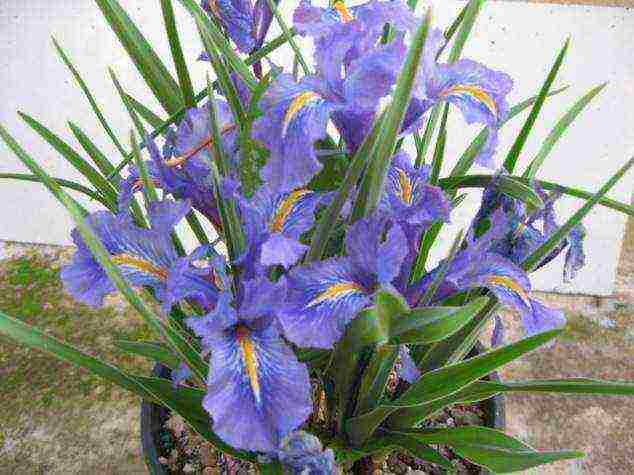

Features of iris care
Dwarf irises are easy to care for and thrive in pots or bowls. The stems grow to a height of 10-20 cm and in late winter or spring bloom with purple or blue flowers, often with white specks. After flowering is over, cut off the flowering stems, leaving the foliage behind. Reduce watering gradually. Remove the yellowed leaves, remove the rhizome, separate all suckers and save the parent rhizome for later planting in a pot or outdoors in early fall. If you have a summer cottage, the offspring of the iris can be planted in the garden, and they will bloom in 2-3 years.
We recommend watching:
Fertilizers for irises
No comments yet. Yours will be the first!
There are two ways of raising cockerels from seed:
- disembarkation in September;
- disembarkation in March.
Freshly harvested seeds are planted in September. This is the easiest way. However, if frosts come late, the sprouts may have time to rise. In this case, they will die.
Better to spend more time but plant the seeds in March. To do this, at the beginning of February, the seeds must be wrapped in a damp cloth, placed in a container with a lid and placed under the freezer. They should be kept at a temperature of 3-5 ° C. The seeds should be stored in this way for 1 month. In March, they need to be planted in a container filled with soil and placed in a warm place. As soon as the sprouts appear, they need to provide additional lighting. It is necessary to transplant sprouts into the ground in May.
Males can be grown at home, however, for this you need to choose only dwarf varieties, since the usual ones will be too tall and voluminous for pots. In order for irises to grow at home, certain conditions must be created for them.
- The soil. Irises work well with fibrous potting soil for bulbous plants, but if you don't have it on hand, you can use regular clay potting potting soil.
- Lighting. Lighting should be moderate during growth and full during flowering. Avoid leaving blooming irises in direct sunlight.
- Temperature. Irises don't like heat. During the flowering period, it is desirable that the temperature is not higher than 16 ° C.
- Watering. Saturate the soil well with water before planting. Subsequently, water the plant once a week. During the flowering period, the frequency of watering should be increased up to 2-3 times a week.
- Top dressing. Introduce liquid plant food 10 days after planting. Then start feeding when the buds form and finish after the yellow leaves are dead.
- Air humidity. Irises love dry air. Spraying is not required for these flowers.
By the way, you can transplant such flowers into open ground at any time. They will continue to grow and bloom.
Try planting different varieties of irises in your home and garden. Outwardly, they are very different in color, shape of petals and even smell. These plants will become a bright decoration of the flower bed.
A perennial plant with a beautiful name iris is in demand among flower growers; it is grown on personal plots, dachas, window sills. Translated from Greek "iris" means rainbow, as the plant has an incredible variety of colors. Another name is also used - "kasatik".
July
At this time, bearded irises of late varieties are still blooming. Do not forget to promptly remove wilted inflorescences from them. Also in July, Siberian, Japanese irises, spuria and others begin to bloom. If the plants do not bloom well and grow on depleted soil, feed them with complex mineral fertilizer.
The end of July is the most suitable time for planting and transplanting bearded irises. At the beginning of the month, set aside an open sunny area for plants with loamy or sandy loam soil with a neutral and slightly acidic reaction. In addition, please note that this place should not be close to groundwater.Dig up the soil to the depth of a shovel bayonet, remove weeds. Then start planting irises.
Types of irises, some of the nuances of their cultivation
A common cultivated species of irises are bearded irises, so named for the soft bristly growths on the lower petals. They are also called "northern orchids". Siberian irises are graceful, resistant to adverse weather conditions, unpretentious, immune to bacteriosis, and are able to heal soil infected with bacteriosis. Japanese (xiphoid iris) are distinguished by an unusual flower shape. Plants are picky, require dry wintering (covered with oak leaves, plastic wrap), slightly acidic soil with uniform, medium moisture during the flowering period. Swamp irises are the most persistent, they grow well near water, in water, on swampy soils, in dry places. The life span of the marsh killer whale is about 8 years. Moreover, it does not require any maintenance at all.
March
When the Sentsy have 3-4 leaves, proceed to the pick. Transplant the plants into separate containers along with an adjoining earthen clod.
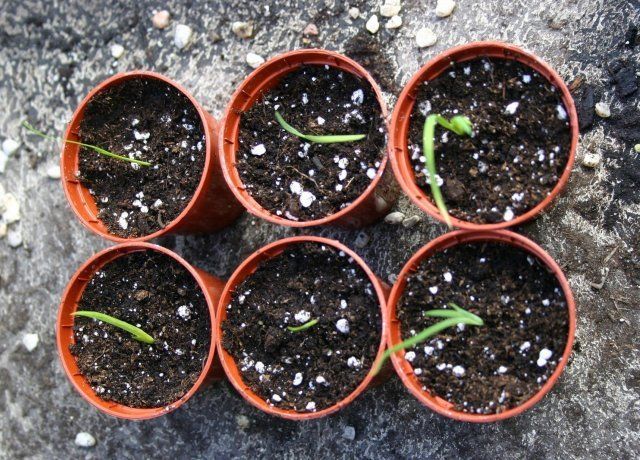

Seedlings of bearded iris
If a lot of water has stagnated in your area with irises after the thaw, then at an air temperature above 7 ° C, install a structure to drain excess moisture.
How to grow irises from seeds
The flowering period of irises in our country lasts from April to mid-July. This does not mean that one variety will delight you for two and a half months, each of them is given no more than 15 days to bloom. Cunning gardeners place several varieties with different flowering periods on the same lawn, admiring the beautiful flowers until mid-summer.
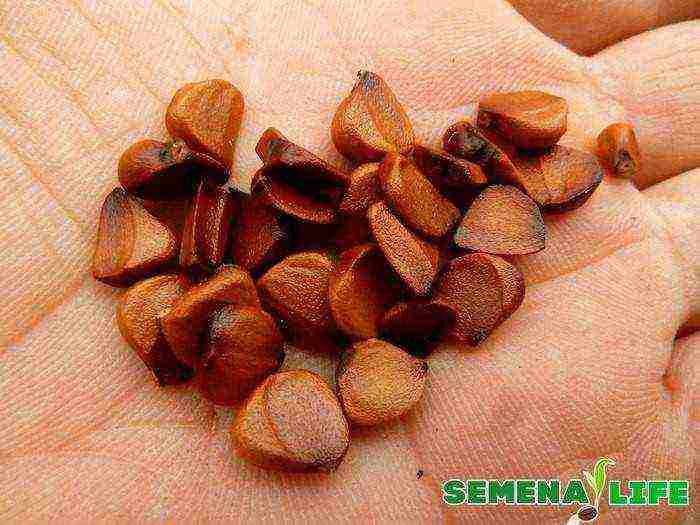

There are never many irises on the site - the unearthly beauty of this flower can be admired endlessly. It is for this reason that many gardeners choose to grow iris from seeds. With specific irises, everything is simple - after the end of the flowering period, right on the stem, carefully pack the box with immature seeds in gauze or synthetic tulle. The seeds ripen until autumn, you can not keep track of the cracking of the capsule.
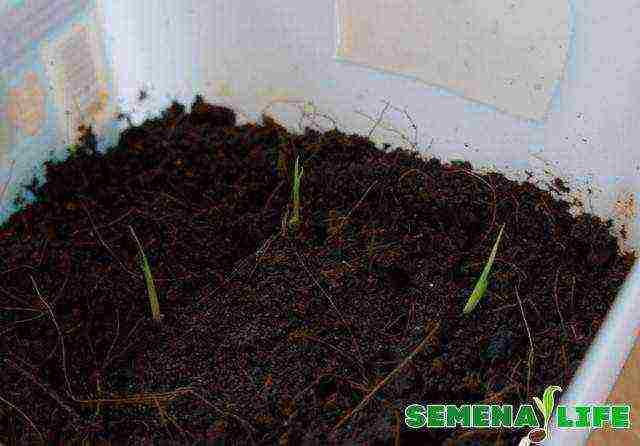

Method number 1
In mid-September, seeds are planted in a garden bed (planting depth - 2 cm, distance between rows and in a row - 10 cm). So that the tender sprouts do not die from frost in autumn and spring, they are covered with padding polyester, which will serve as an air cushion.
Method number 2
The seeds are stratified - wrapped in a damp cloth, placed in a closed container, kept on the top shelf of the refrigerator for 1 month. February is the sowing time, prepare a peat pot for each seed, deepen it by 2 cm. Seedlings need light and warmth.
Seedlings are planted in May.
Both methods are good for breeding specific irises, varietal ones can upset a novice breeder with the appearance of a completely different color, flower shape.
Iris flower (Latin Іris), or Iris, or Cockerel - genus of rhizome perennials of the family Kasatikov, or Irisovs... Irises live on different continents and include more than 800 species of various shapes and colors. In translation, iris means "rainbow".
So named the iris flower Hippocrates in honor of Iris, the goddess of the rainbow. Legend says that when Prometheus gave people fire, a rainbow flared up - so nature rejoiced. The rainbow shimmered all day, evening and night, and when the darkness receded and the sun rose, everyone saw that flowers bloomed on the ground, it was an amazing iris flower that looks like a rainbow. Florence (translated as "blooming") got its name from the Romans because the fields around the city were dotted with irises. The iris flower has been cultivated for more than two thousand years. And they are grown not only as a decoration for gardens, but also as a valuable raw material for the production of essences in the perfumery industry.
February
If you did artificial stratification in the refrigerator, you can start sowing seedlings in January. Keep the seeds at room temperature for a few days, germinate in a damp cloth, and sow in moist, fertile soil.
Sometimes iris seeds germinate slowly. The first wave of sprouts may appear within two months (in Siberian, marsh, smooth, Maak irises), but most of the seeds "sit" in the soil for about 6-10 months (spuria irises, cereal, milky white), and some even germinate only next season (bearded irises, dwarf).
Iris care at home
Temperature:
In summer, the iris flower lays flower buds and the iris hibernates with already formed buds. In delicate iris varieties, flower buds (and the rhizomes themselves) can die at a temperature of -7-10 ° C. Therefore, you should cover the irises for the winter.
Lighting:
It is best to find an open and sunny location, but sheltered from the wind. If you cannot protect the iris flower from the winds, then it is necessary to use supports during the flowering of irises (especially tall ones), otherwise the peduncles may break.
Watering:
Although the iris is a flower and dry-loving, it still has periods when the need for watering increases, namely: young plantings, a period of budding and flowering, a period of active growth of the vegetative mass.
The soil:
It is possible to grow irises on any soil, but they like more light loamy and sandy loamy with a neutral or slightly acidic reaction. The ideal soil for bulbous is lime. An alkaline reaction is provided by lime, chalk or eggshells introduced into the soil during digging. It is better to dilute the sandy soil with humus, ash and about 40 g of superphosphate will not be superfluous.
Bloom:
In the first year, when planting quality planting material, about 60-75% of irises bloom. Also, unfavorable meteorological conditions in spring can destroy the flower bud of the iris. The flowering period of irises is too short - varieties with different flowering periods can be planted, as well as varieties that can bloom again in the fall
Reproduction:
Irises are rhizomatous plants that can grow in one place for several years. The standard planting unit of the bearded iris is the annual link - the "shoulder blade" with a fan of leaves. By the number of leaves, you can usually predict whether there will be flowering next year. If the fan consists of 7-8 leaves, the flower bud should already be laid, and if it consists of 3-4 leaves, you will have to wait 2-3 years for flowering. An iris flower is buried on one side and a part of the rhizome is cut off, which is then divided into annual links. The rest is sprinkled with earth only after disinfection of the sections with wood ash or brilliant green. This solves the problem of not only reproduction, but also the rejuvenation of the plant.
Complexity:
Growing irises at home is an easy way to get beautiful flowers in early spring, when other plants are just emerging from the dormant period. Caring for irises is not difficult and even inexperienced growers can do it.
Diseases, pests and problems in growing neomariki
This plant is more likely to suffer from too much watering than from pests. Neomarica, when the soil is waterlogged, rapidly loses its decorative effect, and this phenomenon manifests itself both at the beginning of the drying of the tips of the leaves, and in the loss of the initially yellowing lower leaves in the rosettes.
In a neglected state, especially with contaminated leaves and during warm wintering, neomariki can be affected by aphids, whiteflies, thrips, weevils. But nevertheless, most often they are bothered by the spider mite, which spreads amazingly quickly on the beautiful large leaves of the plant in dry air.
Like all bulbous-tuberous indoor plants, neomariki suffer from nematodes and other soil pests.With the latter, it is worth fighting an emergency transplant with complete washing and disinfection of the roots. The rest of the pests are fought by a combination of correction of conditions and the use of insecticides.
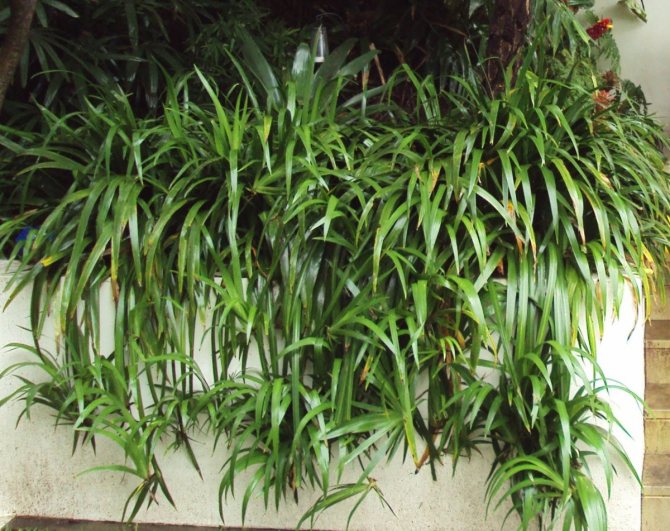

Separation of new sprouts of neomariki is carried out only when the plant releases roots and begins to grow actively.
Fertilizers and transplant
Growing in the wild on poor soils in the mountains of Brazil, neomarica tolerates adverse environmental conditions well. Home care allows feeding.
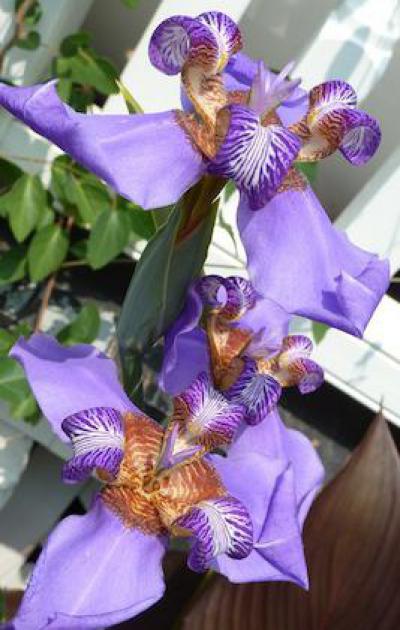

Fertilizer is applied from May to July, during the flowering period. The plant loves fertilizing, it is applied twice a month, which stimulates the growth of abundant greenery in the flowerpot. This option is ideal for growing a luxurious peacock tail or devil's paw in a short period of time. Orchid fertilizer is suitable for this.
With improper care, the apostolic flower can be affected by spider mites. If the apostolic flower is "put on a diet" by cutting back on top dressing and watering, then you can get a neat ampelous plant without lush greenery. A young plant must be transplanted every year in the spring, and adult specimens after 2-3 years, depending on the growth of the iris.
A flower that can decorate the interior both independently and become a lush green background for other plants is unpretentious, but it will be able to thank the beauty and fragrance of the original buds that will delight the eye and heart with their flowering. Get a walking iris in your home - you won't regret it!
October November
Prepare the irises for wintering. If you didn't have time to do it in September, cut off the leaves, and take care of the shelter. In plants of winter-hardy varieties, sprinkle the rhizome with peat in a layer of 10-15 cm. In the second half of October, cover the less winter-hardy irises with spruce branches. It will trap the snow and thereby insulate the plants.
First cover the most fastidious irises with spruce branches or dry leaves, and then, with the onset of frost, stretch a plastic wrap over the pre-installed frame.
In the spring, do not forget to ventilate plants that hibernate under a film shelter.
Before the frost sets in, sow iris seeds in furrows about 3 cm deep or in containers buried in the ground before winter. At the same time, you can send the seeds to the refrigerator for artificial stratification. Keep them there for about three months.


If it is still warm enough at the very end of autumn, complete the work that you did not have time to do in October. But keep in mind: in regions with cold climates, it is too late to sow seeds.
Reproduction
The plant is propagated
in several ways: by children, by dividing the bushes during transplantation, by seeds.
When breeding
children bend them down, substituting a pot of a suitable size and press them to the soil with a wire bracket. After rooting, the peduncle can be removed (after about 2-3 weeks).
When breeding
by dividing the bush with a sharp knife, part of the plant is separated (so that at least three shoots or buds remain). After that, each part is seated in a separate pot. Seed propagation is rarely used: they should only be fresh, their germination period is limited.
About what you need, we have prepared an entertaining article for you.
Red Star Criptanthus can beautify your garden collection. gardener.
How to germinate sweet pea seeds? It's easy with these recommendations.
Where can one buy
You can buy neomarica at almost any outlet that sells indoor flowers. The culture is widespread and is often used to decorate premises.
Online stores and sites where you can buy neomarika:
Neomarica is found very often in public premises, as it does not require long and special care and, despite the short flowering period, is an attractive type of indoor plants.Also, very often this type of flower is used for hanging slides, since the shoots are large during flowering, and the flowers have a pleasant aroma.
In the photo there is an amazing neomarika in different compositions:


A rare and unusual culture diversifies the options for landscaping residential premises. But it is worth remembering that all parts of this culture contain fairly high concentrations of toxic substances. The neomarika flower or walking iris is distinguished by its unpretentiousness and gives abundant flowering even in difficult climatic conditions. This allows you to successfully grow a crop in the garden in the open field in the summer. In this case, the output is excellent cutting material for bouquets and flower arrangements.
The neomarica walking iris is found in large numbers in the wild forests of Brazil, however, as the area of forest plantations decreases, its population also suffers. Therefore, in cultural selection, botanists strive to preserve the original genetic types of culture. There is another name for the flower among the people - the apostolic iris. This is due to the fact that the first flower arrows begin to please with their appearance only after the plant grows 12 leaves. Although there are exceptions to this rule.
When caring for neomarika at home, you must first of all monitor the regularity of watering and applying mineral fertilizers. Look at the photo of a neomarik flower - it is such beautiful and strong plants that you can grow with your own hands:
Care errors and problems
| Problem | Cause |
| Leaves curl | The cause of this problem is most often the excessive influence of sunlight on the flower. |
| Mold has formed on the ground | It occurs most often with excessive watering and lack of drainage in the pot. |
| The plant does not bloom | Such a problem arises most often in the absence of the required amount of sunlight, if the rest period is not observed. |
| Leaves gradually dry out | Excessively dry air is the cause of the problem. To eliminate it, you need to moisten it and spray the plant every three days. |
Is it grown outdoors
Neomarica can be grown outdoors. In order for it to develop well in the open field, the following recommendations must be observed:
- water the bushes every 4 days;
- regularly weed and loosen the soil;
- make organic and mineral dressings in the spring and after flowering;
- timely remove damaged shoots and peduncles after flowering.
At the end of September, the walking iris must be cut off and covered with spruce branches. The culture opens only after the air warms up. The culture is regularly planted or a thinning procedure is carried out. A large number of plantations can negatively affect the size of the inflorescences.
The soil
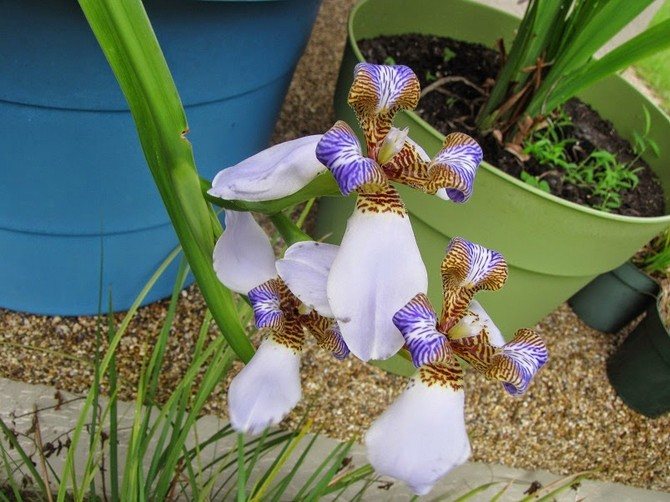

The optimal composition of the soil for growing neomariki can be prepared independently from turf, peat and sand in a ratio of 2: 1: 1. Or you can simply buy specially prepared soil for planting at a regular flower shop. Be sure to put a good layer of drainage on the bottom of the pot.
Watering features
The plant is named after the river nymph Marika for a reason.
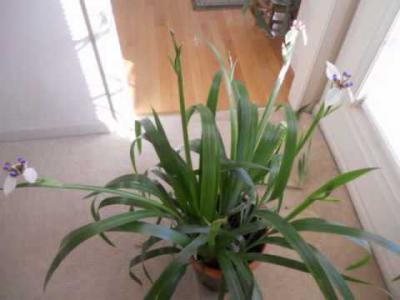

Neomarika is an unpretentious flower, but loves moisture. In summer, iris requires abundant watering, which is reduced in the autumn-winter period by drying the earthen lump under the plant. For irrigation, settled soft water is used; rainwater is perfect. Twice a month, when watering, a few drops of lemon juice or citric acid crystals are added to avoid alkalization of the earth. After flowering, the plant needs a two-week rest, watering during this period stops.
Air humidity is maintained at an average level in the heat by spraying, and the heating season by a periodic shower for the plant.
Lighting and temperature
Windows to the west and east are selected - it is on them that the neomarika will feel good. Home care that provides the plant with soft light will have a beneficial effect on the flower's appearance. He will not tolerate overheating, so it is worth protecting the flowerpot from the scorching sunlight, but the room should be bright. In winter (October - February), he just needs coolness. The flowerpot can be moved to the glass on the windowsill or transferred to a bright room with an ideal temperature of 10 C, for which the plant will respond with grateful flowering in spring.
Read also: Pruning trees in the fall: instructions on how to properly prune shrubs and a garden tree in the fall
Blooming neomariki
In the photo: a fan of neomariki leaves
Another legend says that this plant blooms only when the number of neomariki leaves reaches twelve. Apparently, this is where its name originated "the sword of the apostles", "the apostolic iris": 12 leaves, like 12 apostles ...
Once, when I once again admired the slender leaves of my neomariki (by the way, there were 11 of them), I suddenly noticed something like a new sprout on a peduncle, from which a bud soon appeared. And when this bud opened, the most beautiful flower with an amazing aroma appeared in all its glory!
I already knew that the neomariki bloom would last only one day, so I devoted almost the entire wonderful day to admiring its flower ...
Variety of plant names
Indeed, they say that the new is the well-forgotten old! The rare Brazilian marica plant, home care for which raises many questions among owners today, was a very common flower in the second half of the last century, and it could be seen in almost any institution. Canteens, classrooms, hospital corridors - these are the places where neomarica grew quite successfully.
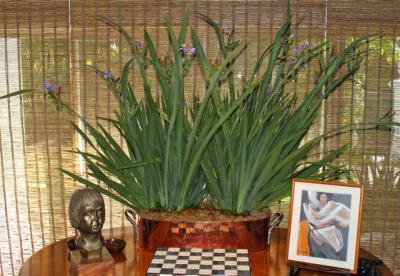

And the name underwent a change: known as the sea, then - marika, and now it is called neomarika. Obviously, "neo" as an addition explains the origin of the plant, pointing to the "New World", that is, America. But among the people this plant is known under other names: • "Apostolic plant". According to legend, it begins to bloom when it releases 12 (according to the number of apostles) leaves, which gently frame a pale lilac flower. • "Walking or crawling iris". Children, located at the ends of the leaves under their own weight, sink to the ground and take root. Due to the movement in this way, the neomarika - the walking iris - got its name. • "Devil's Paw". Spreading greens in the form of fans with pointed leaves up to 80 cm long with daughter racemes on each gives the impression of a shaggy paw.
Landing, soil features
To please the eye of a neomarik, home care must be appropriate. Knowing the original principle of flower reproduction, you need to take care of planting. Small roots allow you to choose a shallow but voluminous wide flowerpot, convenient for the creeping root system of the plant, preferably from ceramic.
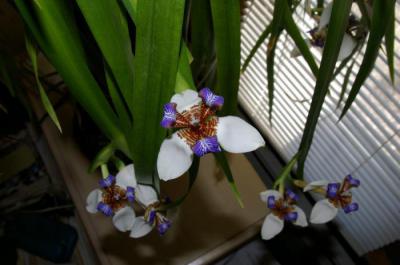

For neomarika to grow well, care is not required of particular difficulty, but watering must be abundant, therefore a good drainage layer is needed. The bottom is covered with chipped bricks, clay shards, expanded clay granules, pieces of polystyrene - everything that is at hand. The composition of the soil for planting is selected in equal proportions of peat, sand and greenhouse soil. This formulation provides a loose soil that is ideally nutritious for the plant. Coniferous mulch is poured on top so that the soil mixture does not dry out.
Favorable conditions
In care, a lot depends on what the owner expects from the plant: luxurious greenery or lush bloom? After all, not only the original flowering attracts neomarika florists.Home care, organized in the right way, allows you to grow a green fan, which will become an indispensable background for decorating a space. Therefore, one should clearly know what we want to receive from the flower of the apostles, and already on the basis of this, the proper conditions created for the plant will be adjusted.
Possible difficulties
In addition to its beautiful appearance, the flower is resistant to diseases. The only common pest is the spider mite. The risk of its occurrence is increased when kept in dry air conditions. The pest is identified by the appearance of a thin cobweb at the edges of the leaves, numerous "punctures" along the surface of the leaf. They do not pull with processing - the flower is bathed in the shower, washed thoroughly with soapy water. It is recommended not to be limited to the means at hand. It is advisable to spray the plant with any insecticide for indoor plants 2-3 times at weekly intervals.
Regular stagnation of water in the soil leads to the development of root rot. The situation is aggravated at low temperatures of detention. The flower is removed from the pot, cleaned from the ground. All damaged roots are cut off, treated with fungicides. They are planted in a new sterile soil.
The lack of flowering indicates a lack of light or lack of a dormant period. Flower bud formation occurs in winter. During this period, low temperatures and intense lighting are needed.
For the rest, neomarica is an unpretentious plant. All that is required from a grower is to provide her with good lighting and carefully monitor the level of humidity.
September
If the beginning of autumn turns out to be warm, in the first decade of September, you can continue to transplant irises. But in regions with an unstable climate, this crop, planted in the fall, may not cope well with the winter, so try to manage it well in advance.
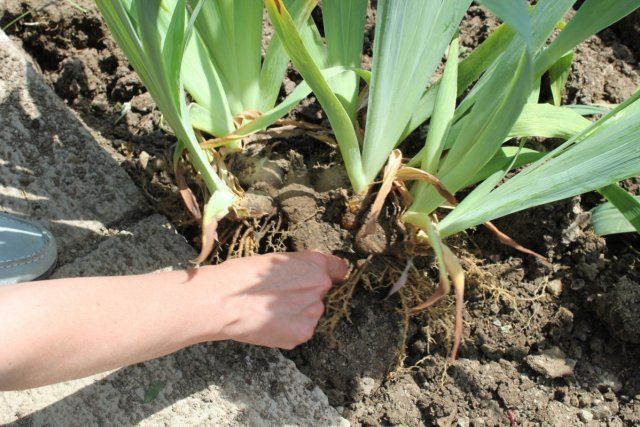

In September, irises are divided only in regions with a mild climate.
It's time to collect the seeds. Gently cut or break off the dried buds, remove the seeds from the fruits and dry them at room conditions. Then place in a paper bag and sign the variety name.
September is the time to carefully weed the irises and prepare them for wintering. At the same time, you can cut the leaves at a height of 10-15 cm. This procedure is necessary so that bacteriosis and fusarium do not develop on the plant, and in the spring the young leaves start growing faster.
Bloom
Most often, the culture blooms in spring. However, with proper care, buds can form throughout the year. Before the formation of buds, it is necessary to apply phosphorus fertilizers, which increase the abundance of flowering.
Photo of flowering beautiful neomariki:

